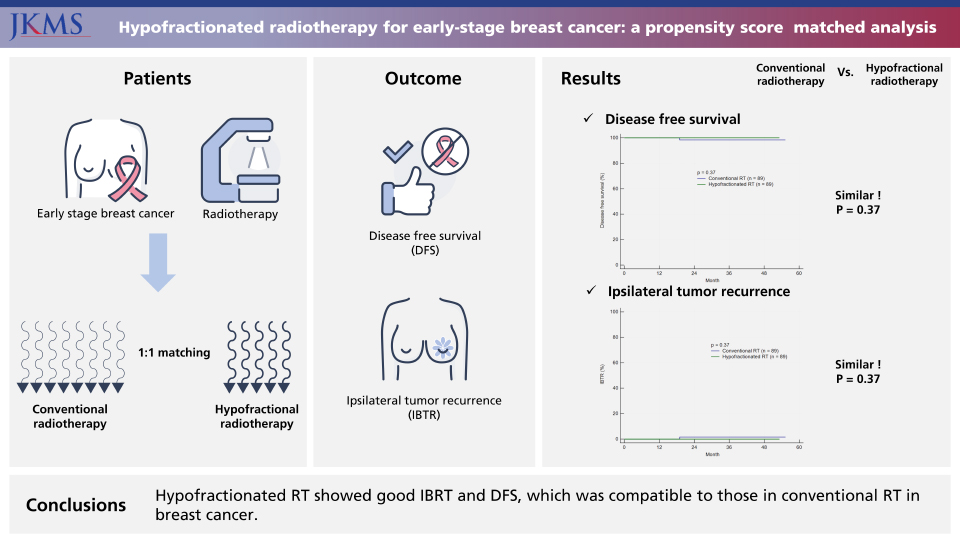글로벌 연구동향
방사선종양학
- [J Korean Med Sci.] Hypofractionated Radiotherapy for Early-Stage Breast Cancer: A Propensity Score Matched Analysis
인제의대 / 이안복, 김희연, 최윤선*
- 출처
- J Korean Med Sci.
- 등재일
- 2022 Feb 28
- 저널이슈번호
- 37(8):e64. doi: 10.3346/jkms.2022.37.e64.
- 내용
Abstract
Background: In patients with early-stage breast cancer, the treatment results of hypofractionated radiation therapy (RT) and conventional RT are evaluated in efficacy and cost.Methods: We retrospectively evaluated 280 patients with early-stage (Tis-2N0M0) breast cancer (including 100 hypofractionated RT patients) with regards to treatment outcomes according to the RT schedule. The median whole-breast RT dose was 42.56 Gy/16 fractions for hypofractionated RT and 50.4 Gy/28 fractions for conventional RT. Most patients (n = 260, 92.9%) additionally received a tumor bed boost RT. We used propensity score matching (PSM) analysis to balance the baseline risk factors for recurrence. The co-primary endpoints of this study were disease-free survival (DFS) and ipsilateral breast tumor recurrence (IBTR). DFS or IBTR was analyzed using the Kaplan-Meier survival curve and log-rank test.
Results: Total 89 pairs of matched patients (1:1 matching, n = 178) were finally evaluated. The median follow-up was 23.6 months. After matching, the 3-year DFS was 100% in the hypofractionated RT group and 98.4% in the conventional RT group; there was no significant difference in DFS between the groups (P = 0.374). Furthermore, the IBTR did not differ between the hypofractionated RT and conventional RT groups (P = 0.374) after matching. The 3-year overall survival was not different between two groups (both 100%). Hypofractionated RT saved 26.6% of the total cost of RT compared to conventional RT. Additionally, the acute skin toxicity rate (≥ grade 2) was also not significantly different between the groups (hypofractionated RT: 10.1% vs. conventional RT: 2.2%).
Conclusion: Hypofractionated RT showed good IBTR and DFS, which were compatible to those in conventional RT in breast cancer. Hypofractionated RT is expected to be used more widely because of its low cost and convenience.

Affiliations
Anbok Lee # 1 , Hee Yeon Kim # 1 , Tae Hyun Kim 1 , Ki Jung Ahn 2 , Heunglae Cho 2 , Sung Kwang Park 2 , Yunseon Choi 3
1 Department of Surgery, Busan Paik Hospital, Inje University College of Medicine, Busan, Korea.
2 Department of Radiation Oncology, Busan Paik Hospital, Inje University College of Medicine, Busan, Korea.
3 Department of Radiation Oncology, Busan Paik Hospital, Inje University College of Medicine, Busan, Korea. rtyoon@gmail.com.
# Contributed equally.
- 키워드
- Breast Cancer; Hypofractionation; Propensity Score; Radiotherapy; Recurrence.
- 연구소개
- 유방 보존술을 시행한 초기 병기(Tis-2N0M0)의 유방암환자들을 대상으로 최근 들어 새롭게 시도된 4주가 소요되는 치료인 저분할 방사선치료 (hypofractionated radiotherapy)를 기존의 6주 치료인 통상 분할 방사선치료(conventional radiotherapy)와 치료 효과, 부작용, 경제성 면에서 비교한 논문입니다. 이 연구에서는 이런 서로 다른 스케쥴의 치료법이 치료 기간 감소에도 불구하고 치료 효과 및 부작용 면에서는 동일한 효과를 가진다는 것을 보여주었으며, 저분할방사선치료는 상당한 비용 절감효과가 있다는 것을 확인할 수 있었습니다.
- 덧글달기
- 이전글 [Sci Rep.] Comparison of clinical outcomes between carbon ion radiotherapy and X-ray radiotherapy for reirradiation in locoregional recurrence of rectal cancer
- 다음글 [J Pers Med.] Effects of Tumor-Rib Distance and Dose-Dependent Rib Volume on Radiation-Induced Rib Fractures in Patients with Breast Cancer









